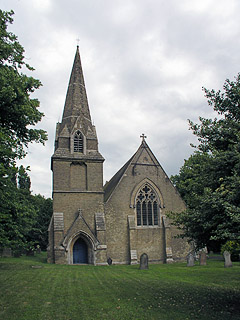The fens have been drained in various phases. The Romans had a decent stab at it, but until the 17th century most of the Isle of Ely was a desolate waste. Then, Vermuyden came, diverted the great fen rivers (the Ouse, the Nene and the Welland) and built the great drains that turned this area into the most fertile farmland in the country. By the 19th century, though, there was a problem. As it dried out, the land shrunk, and the fields now lay well below the level of the rivers. Flooding became a serious problem. Nobody in their right minds would want to live in the low-lying land that could be inundated if the rain fell too heavy in the Chilterns.
And then, there was steam power. The Victorians finished the conquest of the fens by building great pumps to shackle the water in its due courses, and keep the fields safe. It didn't always work, of course, but on the whole it did. And, savouring the sweet black soil left behind, the people moved in. After the drainage, the population of the Isle increased greatly. Long straight roads divided the huge fields, and little villages sprang up at the intersections. And with them came priests, and churches.
The parish of Friday Bridge was officially formed in 1860, and the church of St Mark was completed four years later. It has therefore been standing for a hundred and forty years. I rather doubt that it will stand much longer.
You see, the soil continued to dry out, and the Victorians didn't lay good foundations for their churches. Even the medieval churches in the area have something of a lean (see Elm, for example). St Mark is in the worst state of all. The whole thing - nave, chancel, tower - leans alarmingly to the north. Maybe the parishioners are already getting ready for it to fall, for it seems ill-loved: the walls are dirty, and bricks from the spire have started falling out, giving it a speckled, leprous appearance. Not an encouraging sight.
That having been said, I don't think it will be any great loss. The church is of a brutal, cheap design. The body is effectively just a long plain hall with a steeply pitched roof. The tower stands to the north of the west front, and so there is a grand west window. The other windows in the nave are unpleasant two-light affairs topped with clumsy quatrefoils, all carved out of jaundiced stone. The little porch has boarded up windows with incongruous net curtains, as if to provide a double protection against the awareness of imminent collapse. [Mark adds: adding to the general air of seediness was the fact that the porch was occupied when I looked in it, by some rather scruffy-looking local children - there seemed to be some sort of 'medical game' going on involving a small fat girl showing some part of herself off to three small boys. I recall games like that when i was about 6 or 7, but I don't think we'd have dared do it in a church porch! Oh well, at least they were not doing drugs...]
This building doesn't belong here, in the wide bleak fenland. It is made of yellow London brick, and it's as though the optimistic speculators of the capital brought a suburban preaching hall to stamp their mark on the recently conquered landscape. In Archway or Highgate, St Mark would look at home. Here, it looks ridiculous. Since it was built, the people of Friday Bridge seem to have realised something about survival in the fens. The modern houses are mostly bungalows, and shrink insignificantly on the verge of their awesome and expansive landscape. They seem to say: to live in the fens, one must hardly exist at all. St Mark violates that rule, and the fens are destroying it - crushing it between the sky and the fields until it sinks into the silt.
St Mark was locked, with no keyholders advertised.

